 by Andrea Pelland, Principal, EcoAmmo Sustainable Consulting Inc. Reposted from Perspectives Alberta Chapter CaGBC If you’re a product manufacturer wondering how your product or material can help achieve LEED points, don’t worry – you’re not alone. Confusion as to how the use of product or material can contribute to the achievement of LEED points has led to hastily prepared LEED compatibility forms with misleading or incorrect information. Most often, these mistakes reflect a lack of knowledge about LEED rather than deliberate attempts to sell products, but manufacturers should be aware that the market is evolving and LEED users are becoming much more savvy. Having poorly prepared LEED materials could hurt your reputation. On the other hand, having well-researched and easy-to-understand LEED compatibility information will make it simple and painless for users to specify your product, leaving them feeling assured that you know your stuff! Below are two of the most common errors we see: #1. LEED compatibility forms should tell people which LEED credits the product is compatible with. In other words, articulate how the product will help contribute to the achievement of LEED points. Many LEED forms on the market today state the use of a product will achieve LEED points, or even claim a product is LEED certified. Both of these statements are incorrect because no products are certified or endorsed by LEED, and no LEED credits can be achieved by using just one product! If you ever see claims like these, beware! #2. Many LEED forms confuse product features with LEED compatibility. For example, you might manufacture a hand dryer that contains recycled content in the plastic casing; you might then assume the use of your hand dryer will contribute to the Recycled Content credit. However, the truth is very different. Although the fact that your product contains recycled content is AMAZING and should be plastered all over your marketing materials, the Recycled Content credit does not include mechanical, electrical or plumbing components, and therefore the use of your hand dryer that contains recycled content will not contribute to the achievement of Recycled Content LEED points and should not be included on your LEED compatibility forms. It is important to understand that your LEED forms should stick to "just the facts, ma’am." After careful investigation, you may find your product is directly compatible with only one or two LEED points – that’s okay! It is more important that those one or two points are well thought out and accurate, rather than listing 10 credits that are not actually useful to the LEED user. When your LEED forms are more about product features than actual LEED compatibility, the user will be left feeling skeptical about your LEED knowledge and annoyed at having to re-do your work for themselves. If any of you have had to track down LEED compatibility for yourselves, you will know how frustrating and time consuming the process can be. Therefore, it is very important to thoroughly research and understand how your product fits within the various LEED systems and how to best communicate this to LEED users. For more information, contact us WE can help!
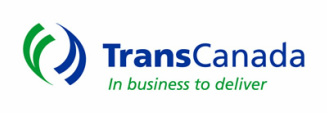 I was excited to read about this today! Enjoy! Repost via energymanagertoday.com November 7, 2012 TransCanada Corporation completed the Quebec-based Gros-Morne wind farm, the final phase of Cartier Wind Energy. Gros-Morne was officially commissioned today. The wind farm was completed one month ahead of schedule and can produce up to 111 MW, enough to meet the needs of over 20,000 Quebec homes every year. The five phases of Cartier Wind Energy has a total capacity of 590 MW, enough to meet the needs of more than 100,000 Quebec homes. All of the power produced by the project is sold to Hydro-Quebec under 20-year power purchase agreements. Cartier is the largest wind farm in Canada and is owned by TransCanada Corporation (62 percent) and Innergex Renewable Energy (38 percent). Combined with the rest of its power portfolio, TransCanada is now providing emissions-free electricity to more than 2.5 million homes in North America. TransCanada also owns, operates or has an interest in: - New England’s largest wind farm – the Kibby Wind Project;
- Thirteen hydro-electric facilities in New Hampshire, Massachusetts and Vermont (nine have already received Low Impact Hydropower Institute certification);
- Bruce Power – the source of roughly 25 percent of Ontario’s electricity;
- Solar – TransCanada will acquire nine solar projects in Ontario which are expected to come into service through 2014.
 As many of you know I would like to have 2 urban hens one day to make killer omelets and teach my family (young and old) where our food comes from. Jeff, my partner in crime, is also a hobby bee keeper and would like to bring one of his hives into the city one day so I don't have to pollinate my tomato and zucchini plants with q-tips. I look ridiculous doing it and those lady bees are just so much better at it then I. So as luck would have it, this beautiful city of ours has been working on a Food & Agriculture Strategy called " fresh: Edmonton’s Food and Urban Agriculture Strategy." Legal urban bees and hens, may not be as crazy as it sounds. Successful legalization of chickens in cities larger then Edmonton, such as Seattle, Chicago and New York are paving the way, with bees gaining ground as more people see the benefits of having these hard working pollinators in food and flower gardens. Bees and hens are pretty quite compared to many of the other animals we are able to keep currently in Edmonton, and there are some brave renegades already keeping them with much success. When I was attending the UofA my roommates had urban hens, not being aware of the bylaw prohibiting such pets. They were fantastic hen caretakers, and kept those chickens through all of our seasons, even winter, with much success. Those chickens became like part of the family. And unlike the lazy cat we had (sorry Chairman Meow), they happens to provide us poor students with delicious eggs, between 6-8 eggs a day! We found that our neighbors were often engaged and excited to receive the fresh eggs too. There were no complaints about noise, or odor, as these hens were precious and treated better then most dogs left in peoples backyards. Success stories like these need to be shared, and I encourage you to learn more, even if you are reading this with your arms crossed, thinking I'm crazy :) So there is a lot of buzz around this initial draft of fresh: Edmonton’s Food and Urban Agriculture Strategy It's beautiful from a graphic design perspective, and I encourage you to read it cover to cover. But it is pretty long, so below I have re-posted a fantastic synopsis, from Mack D. Male, below. As for Friday, October 26, 2012, citizens will be able to share their views with City Council about the draft strategy at a Special Executive Committee Non-statutory Public Hearing ( Here is the Agenda). If you wish to speak at the Public Hearing you can register in advance online and by phone (780-496-8178). You can also watch online on Friday via Streaming Video. Enjoy!
 ___Begin Repost____ Translating the City’s report on the Food & Agriculture Strategy By Mack D. Male · October 19, 2012 at 4:45pm The agenda for next week’s non-statutory public hearing on the Food & Agriculture Strategy is now available online, as is the final draft of fresh: Edmonton’s Food and Urban Agriculture Strategy. In addition to some tidying up and a “fresh” new look, the final draft includes an executive summary. Here’s an excerpt: fresh is not an endpoint, but a starting point. With that in mind, the Strategy does not provide a detailed implementation plan, but rather sets directions for moving forward. Implementation will occur over time as the Edmonton Food Council is established, partnerships are formed, research is continued, resources are allocated and progress builds towards results. Also included in the agenda is a nine-page report prepared by Administration with an overview of the strategy, commentary on the recommendations, and a recommendation to Executive Committee on how to proceed. Here is the recommendation: That Executive Committee recommend to City Council: - That fresh: Edmonton’s Food and Urban Agriculture Strategy, as outlined in Attachment 1 of the Sustainable Development report 2012SPE029, be endorsed in principle.
- That implementation of fresh (Edmonton’s Food and Urban Agriculture Strategy) be postponed pending Administration reporting to Executive Committee in the first quarter of 2013 on the options and costs.
Endorsed in principle, but with implementation delayed pending an update on options and costs. I wasn’t entirely sure why they’d structure the recommendation that way. I mean, since when does Administration implement anything without first gathering options and costs? Why couldn’t Council approve the strategy, if they think it is ready to be approved, and then direct Administration to start implementation immediately, the first step of which might be to gather more information on costs? So I kept reading. Here are the final remarks in the report: While Administration views the recommendations of fresh as being generally reasonable and worthy of follow up, it also sees it being prudent to postpone implementation of fresh pending the development of a better shared understanding between Council and Administration on the options and costs to implement the Strategy. Notwithstanding advice to postpone its implementation, endorsement of fresh in principle will satisfy the requirements of Municipal Development Plan Policy 3.2.1.7 relative to enabling consideration of future Area Structure Plans and will provide City Council with the means to evaluate future Area Structure Plans for the Urban Growth Areas by way of the tool kit contained in strategic direction 9 (see Attachment 3). Right, so allow me to translate. Administration is basically saying: “Look, we have the development industry breathing down our neck and we need to get this taken care of ASAP so that the Area Structure Plans in the Urban Growth Areas can move forward. We know the recommendation that deals with land use raises a bunch of questions, but we don’t think it is important to answer those right now. Also, we don’t want your endorsement to necessarily commit us to implementing anything, even something as straightforward as establishing a food council, so we’re just going to come back with a report on costs and go from there. Cool?”
 Hello Green Building Friends, CanPHI is holding another training session for Passivhaus in Edmonton! November 5th to 9th 8:30am to 5pm - Monday to Friday $1550.00 + GST More details here: http://www.passivehouse.ca/edmonton-2012/You will find the course outline details on the link. For those that took last years course, it is the same except some new speakers and case studies. CanPHI will announce if they plan to have a level 2 course in the future. I attended the course 2 years ago and was very pleased with the content and instructors - I highly recommend it! Please pass this invite along - lets build more energy efficient buildings in Edmonton! Stephani Carter EcoAmmo Sustainable Consulting Inc.
 Dennis and Christy Cuku are justifiably proud of their new home, designed and built by Habitat Studio & Workshop Ltd. Located just south of Spruce Grove, it's spacious, beautiful - and designed to produce as much energy as it uses over of the course of the year. In other words, it's designed to be a net-zero energy house. For its impressive array of sustainable building features, it has earned LEED Platinum certification - the first home in greater Edmonton and only the second in Alberta to do so. LEED for Homes certification requires a comprehensive approach all aspects of green building: energy use and production, low impact, healthy materials, water use, indoor air quality, etc. Powered by two photovoltaic (PV) solar electric arrays that track the sun - there is no gas hookup - its design and anticipated effects are unique in the area. "We hope the project helps raise public awareness about the amount of energy we all use. Our ultimate goal was first to live in this type of home ourselves and, secondly, to use it to raise awareness about energy efficiency and sustainable building practices," said Christy Cuku. The extraordinary energy conservation features were a key factor in achieving the LEED Platinum rating: - 16" cellulose-filled R56 walls
- R90 in the ceilings and attic
- careful detailing to control thermal bridging
- radical reduction of air infiltration (.58 ACH at - 50 Pascals)
- state-of-the-art windows
Energy modelling by the team predicts these measures will reduce the total space heat energy required to 23% of that used by a similar house built with typical construction. Passive solar energy will provide more than 50% of the remaining space heat needed. The house has extensive south-facing glazing. A beautifully finished 2 ½" concrete overlay on all of the floors provides thermal mass to store extra energy and control overheating. This aggressive approach to energy reduction was applied to lighting, appliance and domestic hot water loads. The strategies used are projected to reduce the total annual energy requirements to about 23.5kilowatt hours per year. The grid tied PV system was sized to match this load over the course of the year. In summer, when the system produces more electricity than the house needs, the surplus will be exported to the grid. That surplus will be drawn back out during the winter when the system production falls short of the heating load. The house achieved very high ratings for its performance in many other aspects of green building. Material choices were guided by the consultants at EcoAmmo. All products used were screened for factors such as the effects on occupant health, local manufacture, sustainable manufacturing and harvesting practices, recycled content and embodied energy. Water is a big issue on a rural site. A great deal of attention was given to reducing water use, inside and out. Water for landscaping was reduced by using local and drought-tolerant plants and limiting grass areas. Rainwater is collected from more than 90% of the roof area and stored in two cisterns with a total capacity of 5,500 gallons. Cost of the two-storey home, with 4,025 square feet of living space on the two main floors and 2,050 square feet in the basement suite, is estimated at $25,000 above a similar home with regular construction - but the homeowners anticipate the reduced operating savings to more than make up the difference over their mortgage period. Energy and water use has been calculated based on two families occupying the dwelling. The Cuku family and their neighbours aren't the only ones interested in the energy-saving potential of the new home. The home is located in Parkland County, and County officials are interested in working with the Cuku family and Habitat Studio to learn more about the technologies and strategies used in increasing energy efficiency. Project Team: Peter Amerongen, Habitat Studio & Workshop - Project Manager Stephani Carter, EcoAmmo - LEED Accredited Professional Brandy Burdeniuk, EcoAmmo - LEED Accredited Professional Kim Chiles, Midori Spaces - Green Interior Design Specialist Gordon Howell, Howell Mayhew - Electrical Engineer & PV Specialist Learn more about the Cuku home and net-zero homes in general.
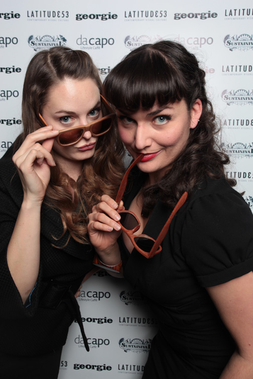 As we mentioned before, YEGwood launched their new line of wooden glasses over the weekend, and we were there to celebrate. We also joined in on the photo contest fun! If you are so inclined, you should vote for Stephani and I (Brandy) and we might just win a pair of those fancy shades. VOTE HEREPhoto Credit: Ashley Champagne
(Reposted from Metro)Yegwood is throwing a launch party Dec. 17 at DaCapo Cafe for their new line of environmentally-friendly sunglasses 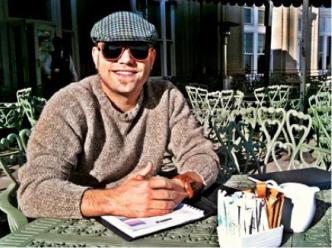 When Edmonton entrepreneur Joey Hundert started his latest venture, he knew Yegwood (eco-friendly Wayfarer style shades) was a great idea, but he also knew he needed more than an event to spread the word. “The frames are all-natural woods, typically cut from one solid block of wood. We choose wood because it tells such a great story, whether it’s a recycled century-old abandoned bar, old maritime ships, or beetle-kill from B.C. This is visible in the constant grain patterns on our glasses, where the rings and sometimes even knots can be distinguished,” Hundert explains. While the concept is cool, it’s a mouthful to sell. So Hundert and his team got creative. Relying on the old adage of a picture being worth a thousand words, the team decided to blend an event with a photo contest in order to test the market. “We sponsored Sustainival, the eco-friendly carnival that took place at the Fringe Festival and that was our first public outing,” says Hundert. “People truly freaked out over our stuff. We held a photo contest at the Fringe and it sparked a huge wave of viral interest in our online story and story.” In fact, over 30,000 people viewed the contest website during the 10 day festival. The contest winner garnered over 500 votes alone. That was enough evidence to get Hundert to organize a stand-alone event for the new line on Dec. 17 at DaCapo Cafe (8739 109 St.). “We’re throwing a launch party to celebrate the new line of Yegwood sunglasses.” In addition to being entertained by one of Edmonton’s most legendary DJ’s (Remo de Janeiro), Yegwood is hosting another photo contest where contestants sport one of the new pairs of shades, style it up, and get their photo snapped in a photo booth by a local pro. The pics are then uploaded to Facebook and yegwood.com where people will vote for their favourite glam shot. The winner walks away with a custom pair of wood frames worth over $400 and some cool art from Latitude 53. For more information, visit yegwood.com Yegwood launch party is Dec. 17 at DaCapo Cafe
 Walk into EcoAmmo's office, and you're immediately embraced by the airy, inviting, arty and uplifting interior. You're also witnessing some of the qualities that earned EcoAmmo its first place award for the one to 10 employee category of the City of Edmonton's first-ever Small Business Eco Challenge Award. Combine EcoAmmo's low volatile organic compound (VOC) paint, its environmentally friendly flooring, its too-cool movable wall (cost-effectively made in Red Deer) and the salvaged and refurbished ergonomic office chairs with the "walk the talk" attitude of its three enthusiastic partners, and the reasons for their accolades from the City are obvious. The Small Business Eco Challenge celebrates the environmental achievements of small business operating in Edmonton. "We're conservers first. We put a lot of thought and effort into making the most we can of what we have," says Brandy Burdeniuk, EcoAmmo principal. "We even compost everything possible." The trio guide and consult on elements including transportation, water use, energy use, carbon monitoring, event tracking and sustainable interiors and finishings. Their focus is operations monitoring - helping clients assess each element of their operation to improve its efficiency and reduce its carbon footprint. "We test all kinds of different paints and floorings for our clients so they know what the true experience is going to be," says Stephani Carter, EcoAmmo principal and former Alberta Chapter, CaGBC Board member. "Our own office is designed to be disassembled if and when we leave this location." The principals' dedication to all things green extends beyond office hours. Two of the three partners walk to work even in winter. One lives outside walking range - but her Smart Car keeps their transportation as fuel-efficient as possible. The City of Edmonton award recognizes the firm's sustained dedication to the environment, noting EcoAmmo's green initiatives include: - use of energy-efficient lighting,
- use of local food suppliers for catering,
- maintaining a paper-free office (no printer, fax or copier), and
- encouraging clients to implement water-saving strategies at events.
To read more on this award, to watch the video of the winners or to review the application for next year, please visit the City of Edmonton's website.
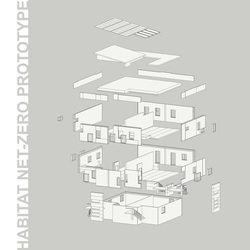 Teamwork, vision and out-of-the-(building) envelope thinking have proven the recipe for success for an exciting net-zero energy Habitat for Humanity Edmonton (HFHE) home in Edmonton. The net-zero duplex, the first of its kind in Canada, is a collaborative effort of several local firms committed to sustainability and the Alberta Chapter, Canada Green Building Council (CaGBC). Project leaders Lafarge and Stantec got the ball rolling. Lafarge initiated the project as a showcase for innovative use of a precast concrete envelope while Stantec provided the architectural design and sustainability consulting. The integrative by Kassian & Dyck for structural engineering, 3D modeling and detailing as well as Vital Engineering for mechanical and geothermal design. Other local firms are contributing to the sustainable interior.The Alberta Chapter, CaGBC, also deeply committed to the project, donated the LEED for Homes provider and energy modeling (EcoAmmo and EcoSynergy) to ensure the project would be designed and constructed to LEED standard. Since the building is identical in size, orientation and footprint to previous HFHE duplexes built using traditional framing and construction methods, the project team will measure and verify the home's energy performance over the next five years and compare the results with their traditionally built twins. The duplex is currently on track for LEED Platinum certification. "From the beginning, the project was intended to be sustainable with net-zero becoming a real possibility when we were able to achieve an EnerGuide 86 rating with the envelope alone. Dow's contribution of special insulation material for the panels provided a real boost," said Klaas Rodenberg, Stantec's Sustainable Design Coordinator. Construction on the new duplex began this fall. The structure is manufactured in modules at the Lafarge precast plant where windows, doors and other openings are installed in controlled conditions before being shipped to the Riverdale site for assembly."This innovative project offers exemplary environmental performance," said Keith Shillington, Vice President, Stantec, Edmonton Region. "This results in lower monthly utility costs that make this home attainable for more hard working families in Edmonton."Highlights of the environmentally progressive features include: - a high-performance envelope that enhances energy performance, good health, air quality, etc.,
- water efficient fixtures,
- nativescaping,
- infill development close to a bus stop,
- geothermal heating,
- solar PV panels, and
- solar thermal panels for hot water."We are creating the ultimate energy-efficient precast concrete home. The project offers a solution that delivers on environmental, economic and social aspects of sustainability," said Rene Thibault, Western Canada Aggregates & Concrete Regional President, Lafarge North America.The project will be the stepping stone for venturing into creating more sustainable residential solutions with precast concrete. Once complete, the home will be donated to HFHE.
"Habitat for Humanity is partnering with innovative companies and organizations to find sustainable solutions for affordable home ownership," said Susan Green, Chair, HFHE. "We are very grateful to Lafarge and Stantec for selecting Habitat as the beneficiary of this pioneering initiative."
The HFHE project was a featured presentation at Greenbuild 2011. Check out the Greenbuild presentation video - a great source for information on the project and how these kinds of opportunities continue to enhance the Alberta Chapter's reputation nationally and internationally for supporting innovation in our industry.
 The January 2011 edition of Perspectives offered an article about Habitat for Humanity Edmonton's (HFHE) largest - and greenest - build to date, the 47-family Anderson Gardens at 123 Avenue and 41 Street in Edmonton.
The homes, being built to a Build Green standard, raised the bar for attractive, sustainable and affordable homes.
On June 29 this year, HFHE celebrated their 20th anniversary by giving 10 families keys to their new homes in Anderson Gardens, the largest Habitat for Humanity Built Green project in all of Canada.
Alfred Nikolai, HFHE President and CEO, says he hopes 40 of the 47 homes will be completed by Christmas. "That's wishful thinking, but if the good weather continues, we'll do it."
He also says the Build Green team have been great to work with.
"There are really two environmental pillars at Anderson Gardens. First is the way we build the homes and incorporate energy efficiency into each home. The second aspect is our landscaping. It wasn't an accident this community is called a garden."
Alfred says HFHE is working with Evergreen Canada from Toronto to help design appropriate, sustainable landscaping. "A great portion of the footprint on our site will remain green."
Watch for details of the upcoming Riverdale project, a partnership between Habitat for Humanity Edmonton, Stantec, Lafarge, EcoAmmo, EcoSynergy, Vital Engineering, Kassian Dyck Associates and the Alberta Chapter - CaGBC. Alberta Chapter Past Chair, Klaas Rodenberg is presentating the project at the Chapter Forum October 4 at Greenbuild in Toronto. This exciting venture has been submitted for an American Institute of Architects (AIA) award.
|






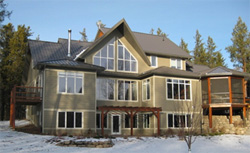





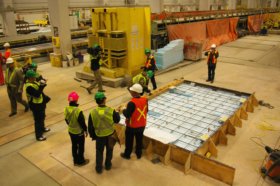

 RSS Feed
RSS Feed